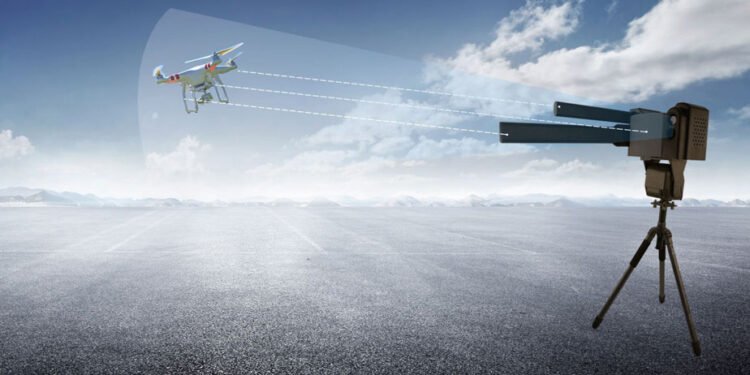How Drone RF Detection Enhance Security Systems
The detection of drones through Radio Frequency (RF) signals has become a vital component in modern counter-Unmanned Aerial Systems (C-UAS) technologies. Drones rely on RF communications to maintain contact with their operators, navigate, and receive control commands. By detecting and analyzing these RF signals, security systems can identify, track, and neutralize unauthorized drone activity. The effectiveness of RF detection systems lies in their ability to monitor the radio frequency spectrum for signals emitted by drones and their communication links. When combined with Drone Jammer Gun and Audio Jammers, these systems can provide a dynamic and adaptive response to neutralize threats. Below, we explore how RF detection works in more detail.
Radio Frequency Signals
Drones typically communicate with ground control stations via RF signals, which are transmitted between the drone and its operator. These signals are used for various purposes, including control commands, video feed transmission, telemetry data, and navigation updates. The RF spectrum spans a wide range of frequencies, with different types of drones using different frequencies depending on the model, communication technology, and geographic region.
RF detection systems rely on specialized sensors designed to scan the RF spectrum for signals emitted by drones. These sensors can detect the presence of a drone based on the strength, frequency, and modulation of the RF signals. RF systems are highly effective because they can detect signals over long distances, even in environments where visual detection may be challenging, such as forests, urban areas, or remote locations. The primary goal of RF detection is to pinpoint the presence of unauthorized drones operating within a specific airspace, giving security teams a chance to assess and respond.Additionally, Audio Jammers can be used to disrupt any sound-based sensors or communication systems on the drone, further preventing it from completing its mission.
Geolocation and Signal Analysis
Once an RF signal is detected, the next step is to locate the drone in real time. This is achieved through a process called geolocation, which uses multiple RF sensors placed at different locations to triangulate the position of the drone. These sensors measure the strength of the RF signal, as well as the time it takes for the signal to reach each sensor, enabling the calculation of the drone’s position in three-dimensional space (latitude, longitude, and altitude).
Triangulation involves measuring the signal strength or time delay from at least three different sensors positioned at known locations. By comparing the arrival time or strength of the RF signals at each sensor, the system can calculate the drone’s precise location. Advanced RF systems may also use time of flight (TOF) or angle of arrival (AOA) methods to refine their geolocation capabilities.
This real-time tracking allows security operators to monitor the drone’s movement, including its direction, speed, and altitude. The system can then display the drone’s position on a map or provide alerts if it is entering a restricted area. In high-security environments, such as airports, military bases, or critical infrastructure, this geolocation process is vital for maintaining a secure perimeter and neutralizing potential threats.
Frequency Bands Detected
Drone RF Detection systems are designed to detect and analyze specific frequency bands commonly used by drones for communication. These frequency bands are divided into different ranges, and the most common ones include:
- 2.4 GHz: This frequency is one of the most commonly used for drone control and video transmission. It is often used in consumer-grade drones and some industrial drones for short-range communication. The 2.4 GHz band is also used by Wi-Fi devices and other wireless communication systems, which means that RF detection systems must filter out background noise from other sources while identifying drone signals.
- 5.8 GHz: Another widely used frequency band, particularly for high-definition video transmission. Many drones use this frequency to transmit live video feeds to the operator, making it an important target for RF detection systems. Like 2.4 GHz, the 5.8 GHz band is shared with other devices such as radar, Wi-Fi, and satellite communications, so the RF detection system must be able to isolate the drone signals.
- 1.3 GHz and 900 MHz: These bands are often used by long-range drones and those designed for industrial or military applications. Drones that operate in these frequency ranges typically have longer communication ranges and may be used for more advanced applications, such as surveying or surveillance. Detection systems need to be tuned to recognize these less common frequency bands as well.
- Other Custom or Encrypted Bands: Some drones, especially those designed for military or advanced commercial use, operate in custom or encrypted frequency bands. These systems may use frequency hopping or dynamic frequency selection to avoid detection or interference, making them more difficult to identify using traditional RF detection methods. Advanced RF detection systems must be capable of identifying and decoding these encrypted signals or tracking the drone’s communication patterns in real time.
RF detection systems can also use a combination of frequency bands to differentiate between drones, other RF sources, and environmental noise. By analyzing the signal patterns and modulation techniques, the system can more accurately identify the specific characteristics of the drone’s communication system and classify it.
Advanced Detection and Tracking Capabilities
In addition to detecting common RF frequency bands, modern RF detection systems are increasingly equipped with advanced capabilities to enhance detection accuracy and reliability:
- Signal Strength and Quality: RF detection systems can evaluate the signal strength and quality of the transmission, allowing operators to determine the distance and proximity of the drone. A stronger signal usually indicates a closer drone, while a weaker signal may indicate a drone that is further away or operating at a lower power setting.
- Signal Modulation and Coding: Drones often use specific modulation schemes (such as frequency modulation or amplitude modulation) and coding methods (such as spread spectrum or pulse codes) for their communication signals. By analyzing these unique features, RF systems can differentiate between various types of drones and filter out non-drone RF sources.
- Noise Filtering and Anti-Jamming: RF detection systems employ sophisticated filtering techniques to reduce false positives and isolate drone signals from other RF sources in the environment. This is particularly important in crowded urban areas where numerous devices may be operating in the same frequency bands. Anti-jamming technology also plays a crucial role in ensuring the reliability of RF detection, preventing malicious interference from disrupting the system.
Challenges in RF Detection
While RF detection is a powerful tool for identifying and tracking drones, it does face several challenges:
- Signal Obstruction: Physical obstacles, such as buildings or trees, can interfere with the RF signals and make it difficult for sensors to detect and triangulate the drone’s position. This can be mitigated with multiple sensor deployments across a wide area.
- Encrypted Signals: Drones using encrypted or low-power RF signals pose a significant challenge for detection systems, as these signals are harder to detect and decode. Advanced signal processing techniques and AI-powered systems are being developed to counteract these challenges.
- Environmental Noise: In crowded RF environments, detecting drone signals among background noise from other wireless devices can be difficult. High-performance RF sensors and signal filtering algorithms are needed to isolate drone communications effectively.












